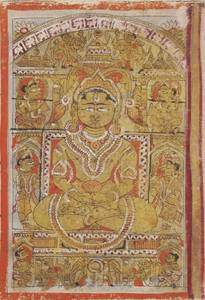A. Introduction: Jainism
First revision: Apr.28, 2020
Last change: Feb.12, 2023
Search, Gather, Rearrange, and Written by Apirak Kanchanakongkha.
286
Chapter VI01.
THE PLURALISTIC REALISM OF THE JAINAS
Jainism - Life of Vardhamāna - Division into Śvetāmbaras and Digambaras - Literature - Relation to Buddhism - The Sāṁkhya philosophy and the Upaniṣads - Jaina logic - Five kinds of knowledge - The Nayas and their divisions - Saptabhaṅgī - Criticism of the Jaina theory of knowledge - Its monistic implications - The psychological views of the Jainas- Soul - Body and mind - Jaina metaphysics - Substance and quality - Jīva and ajīva- Ākāśa, Dharma and Adharma - Time - Matter - The atomic theory - Karma - Leśyās - Jīva's and their kinds - Jaina ethics - Human freedom - Ethics of Jainism and of Buddhism compared - Caste - Saṅgha - Attitude to God - Religion - Nirvāṇa - A critical estimate of the Jaina philosophy.
I
JAINISM
As the Buddhists are the followers of Buddha, the awakened, the Jainas are the followers of Jina, the victor, a title applied to Vardhamāna, the last prophet of the Jainas. It is applicable also to those men and women who have conquered their lower nature and realised the highnest. The name Jainism indicates the predominantly ethical character of the system.
II
VARDHAMĀNA
Vardhamāna, the elder contemporary of Buddha, was the second son of a Ksatriya chieftain in Magadha, the Modern Behar. According to the tradition, he was born in 599 B.C. and he died in 527 B.C. "Vardhamāna was like his father, a Kāśyapa. He seems to have lived in the house
287
of his parents till they died, and his elder brother, Nandivardhana, succeed in what principality they had. Then at the age of twenty-eight, he, with the consent of those in power, entered the spiritual career, which in India, just as the Church in Western countries, seems to have offered a field for the ambition of younger sons. For twelve years he led a life of austerities, visiting even the wild tribes of the country, called Rādha. After the first year he went about nakes. From the end of these twelve years of preparatory self-mortification dates Vardhamāna's Kevaliship. Thereafter he was recognised as omniscient, as a prophet of the Jainas or a Tīrthaṅkara (the founder of the path), and had the titles Jina (spiritual conqueror), Mahāvīra (great hero), etc., which were also given to Śākyamuni. The last thirty years of his life he passed in teaching his religious system, and organising his order of ascetics, which, as we have seen above, was patronised, or at least countenanced, chiefly by those princes with whom he was related through his mother."1 Vardhamāna called himself the expounder of tenets held by a succession of twenty-three earlier sages or tīrthaṅkaras, whose history is more or less legendary. He was not so much the founder of a new faith as the reformer of the previously existing creed of Pārśvanātha, who is said to have died in 776 B.C. Jaina tradition ascribes the origin of the system to Ṛṣabha, who lived many centuries back. There is evidence to show that so far back as the first century B.C. there were people who were worshipping Ṛṣabhadeva, the first tīrthaṅkara. There is no doubt that Jainism prevailed even before Vardhamāna or Pārśvanātha. The Yajurveda mentions the names of three Tīrthaṅkaras-Ṛṣabha, Ajitanātha and Ariṣṭanemi. The Bhāgavata Purāṇa endorese the view that Ṛṣabha was the founder of Jainism. Whatever be the truth of it all, the Jains believe that their system had previously been proclaimed through countless ages by each one of a the succession of great teachers.
 Images of Ṛṣabha, Worship of Ṛṣabha, Image by Victoria and Albert Museum @ V&A Images/Victoria and Albert Museum, London, Source: www.jainpedia.org, access date: 17 September 2020.
Images of Ṛṣabha, Worship of Ṛṣabha, Image by Victoria and Albert Museum @ V&A Images/Victoria and Albert Museum, London, Source: www.jainpedia.org, access date: 17 September 2020...............................
1 Jacobi, Introduction, p. xv., S.B.E., vol. xxii ; see also pp. 217 ff.
Vardhamāna's followers were drawn chiefly from the Kṣatriya aristocracy, and he organised them into a regular community, with lay and monastic members of both sexes. We have reason to believe that under the influence of Vard-
The twenty-four Tīrthaṅkaras02.
| No |
jina |
colour |
emblem (Śvet.) |
Guardian spirits (Śvet.) |
place of birth |
place of nirvāṇa |
| 1 |
Ṛṣabhanātha or Ṛṣabhadeva - Adinatha |
yellow |
bull |
Gomukha and Cakreśvari |
Vinītānagara |
Aṣṭāpada (Kailāśa) |
| 2 |
Ajitanātha |
yellow |
elephant |
Mahāyaksa and Ajitabalā |
Ayodhyā |
Sameṭa-Śikhara |
| 3 |
Saṁbhavanātha |
yellow |
horse |
Trimukha and Duritārī |
Śrāvasti |
Sameṭa-Śikhara |
| 4 |
Abhinandananātha or Abhinandana |
yellow |
monkey |
Nāyaka and Kālikā |
Ayodhyā |
Sameṭa-Śikhara |
| 5 |
Sumatinātha |
yellow |
red goose |
Tumburu (or Tumbura) and Mahākālī |
Ayodhyā |
Sameṭa-Śikhara |
| 6 |
Padmaprabha or Padmaprabhu |
red |
red lotus |
Kusuma and Śyāmā |
Kauśambī |
Sameṭa-Śikhara |
| 7 |
Supārśhvanātha |
yellow |
swastika |
Mātaṅga and Śāntā |
Vārāṇasi |
Sameṭa-Śikhara |
| 8 |
Chandraprabha or Candraprabhu |
white |
moon |
Vijaya and Bhṛikuṭī |
Candrapura |
Sameṭa-Śikhara |
| 9 |
Pushpadanta - Suvidhinātha |
white |
crocodile |
Ajita and Sutārakā |
Kānaṇḍīnagara |
Sameṭa-Śikhara |
| 10 |
Śītaḷanātha or Shitalanatha |
yellow |
śrīvatsa |
Brahmā and Aśokā |
Bhadrapura |
Sameṭa-Śikhara |
| 11 |
Shreyanasanatha or Śreyāṁsanātha |
yellow |
rhinoceros |
Yakṣeṭa and Mānavī |
Siṃhapura |
Sameṭa-Śikhara |
| 12 |
Vāsupūjya |
red |
buffalo |
Kumāra and Caṇḍā |
Campā |
Campā |
| 13 |
Vimaḷanātha |
yellow |
wild boer |
Ṣānmukha and Viditā |
Kampīlya |
Sameṭa-Śikhara |
| 14 |
Anantanātha |
yellow |
falcon |
Pātāla and Aṅukuśā |
Ayodhyā |
Sameṭa-Śikhara |
| 15 |
Dharmanātha |
yellow |
Thunder |
Kinnara and Kandarpā |
Ratnapurī |
Sameṭa-Śikhara |
| 16 |
Shantinātha |
yellow |
deer |
Garuḍa and Nirvānī |
Hastināpura |
Sameṭa-Śikhara |
| 17 |
Kunthunātha |
yellow |
goat |
Gandharva and Balā |
Hastināpura |
Sameṭa-Śikhara |
| 18 |
Aranātha |
yellow |
nandāvartta |
Yakṣeṭa and Dhaṇā |
Hastināpura |
Sameṭa-Śikhara |
| 19 |
Māllīnātha |
blue |
pitcher |
Kubera and Dharaṇapriyā |
Mithilā |
Sameṭa-Śikhara |
| 20 |
Munisuvrata or Suvrata |
black |
turtle |
Varuṇa and Naradattā |
Rājagṛiha |
Sameṭa-Śikhara |
| 21 |
Naminātha |
yellow |
blue lotus |
Bhṛikuṭi and Gandhārī |
Mathurā |
Sameṭa-Śikhara |
| 22 |
Neminātha |
yellow |
shell |
Gomedha and Ambikā |
Sauipura |
Girnār (Girinagara) |
| 23 |
Parshvanatha or Pārśvanātha |
blue |
snake |
Dharaṇendra and Padmāvatī - Lakṣmī |
Vārāṇasi |
Sameṭa-Śikhara |
| 24 |
Mahāvīra |
yellow |
lion |
Matāṅga and Siddhāyikā |
Kuṇḍalapura |
Pāpā (Pāvāpuri) |
288
hamāna followers of two different creeds had joined the order, those who agreed with him that complete abandonment of possessions involved the giving up of all clothing, and those of the order of Pārśvanātha, who stopped short of this extreme measure of renunciation and looked upon clothing as a necessity. Perhaps this fact is referred to in the Uttarādhyayana1 account of the union of the two churches of Keśi and Gautama. This question of clothes versus no clothes led to the great schism and division of the Jainas into the Śvetāmbara (white robe) and Digambara (skyclad or nude) sects, which took place in A.D. 79 or 83.
These two sects are distinguished not so much by their philosophical views as by their ethical tenets. The Digambaras hold that Kevalins or perfect saints live without food, that a monk who owns any property such as wearing clothes cannot reach nirvāṇa, and that no woman can attain liberation. They represent the Tīrthaṅkara as nude, unadorned and with downcast eyes, and think that Vardhamāna never married. They disown the canonical books of the Śvetāmbaras and themselves possess none.
The 24 Founders of Jainism03.
1. Ṛṣabhanātha or Ṛṣabhadeva or Rushabhdev - Adinatha (พระฤษภเทพ หรือ พระอาทินาถ) - Rushabh became the first king of the city of Ayodhya and helped improve the lives of all citizens. He made advancements in the field of music, architecture, and math. After many successful years of rule, he passed down his kingdom to his children and decided to become a monk. One day, he decided to take a vow of total silence until he was offered food to eat. People would bring him expensive gifts, but Rushabh would not break his meditation.
Rushabh traveled to the city of Hastinapur. The king of Hastinapur offered Rushabh jewelry, but still, he did not say anything. Suddenly, the great king realized that Rushabh must be hungry and offered him sugarcane juice. Finally, one year after he began his oath of silence, Rushabh spoke again! Jains celebrate this day as Akshay Tritiya. Eventually, Rushabh traveled around India, teaching the principles of Jainism. It is for this reason that he is also popularly known as Adinath (the first lord).
III
LITERATURE
The faith was preserved in men's minds, as usual. The knowledge of the scriptures was slowly decaying, till in the fourth century B.C. the need for fixing the canon was keenly felt. A council met for the purpose at Pāṭaliputra near the end of the fourth century, B.C., though the final form of canon is due to the Council at Valabhī, presided over by Devarddhi some 800 years later, about 454 A.D. Eighty-four works are recognised as belonging to the canonical literature. Among them are forty-one Sūtras include the eleven Aṅgas, the twelve Upāṅgas, the five Chedas, the five Mūlas and eight miscellaneous works, such as
..............................
1 Lecture XXIII.
289
Bhadrabāhu's Kalpasūtra.1 These were in Ardha-Māgadhi, but Sanskrit became a favorite language of Jainism after the Christian era. According to the Digambaras, it was in A.D. 57 that the sacred lore was reduced to writing, when those learned in it were not available, and the only sources of information were what people remembered about the sayings of Vardhamāna and the Kevalins. The scriptures relating to the seven tattvas, the nine padārthas, the six dravyas and the five astikāyas,2 were formed on their basis.3
IV
RELATION TO OTHER SYSTEMS
Buddhism and Jainism deny the existence of an intelligent first cause, adore deified saints, possess clergy practising culibacy, and think it sinful to take the life of any animal for any cause. Their founders are men who made themselves perfect, though they were not always so.
..............................
1 Translated by Jacobi in S.B.E., vol xxii.
2 See Jaini : Outlines of Jainism, appendix v.
3 Among the extra-canonical works of the Śvetāmbaras, the following are of philosophical interest : (I) Umāsvāti's Tattvārthādhigama Sūtra (after 3rd century A.D.). It has ten chapters, and has been commented upon by many writers. It is a very popular book. (2) Siddhasena Divākara's Nyāyāvatāra (5th century A.D.). (3) Haribhadra's Ṣaḍdarśanasamuccaya (9th century A.D.). (4) Merutuṅga's (14th century A.D.) Ṣaḍdarśanavicāra. Navatattva belongs to this period, though its author is unknown. Among the chief philosophical works of the Digambaras may be mentioned :
Sources, Vocabulary, and Narratives:
01. from and a little adaptation. INDIAN PHILOSOPHY Volume 1: S. Radhakrishnan, Oxford University Press, Fifth impression 1999, Page 286-340.
02. from and a little adaptation. JAINISM, History, Society, Philosophy and Practice, written by Agustín Pániker, MOTILAL BANARSIDASS Publisher, Reprint 2017, Delhi India, ISBN: 978-81-208-3460-6, page 64.
03. from and a little adaptation. Jainism for Children. The 24 Founders, written by Nish Shah, illustrated by Roberto Gonzalez, 2020.
PHOTO GALLERY
Pic 01: from. www.veganfirst.com, access date 1 September 2020.
Pic 02: from. www.srmd.org, access date 16 September 2020.
Pic 03: Images of Ṛṣabha, Worship of Ṛṣabha, Image by Victoria and Albert Museum @ V&A Images/Victoria and Albert Museum, London, Source: www.jainpedia.org, access date: 17 September 2020. 





